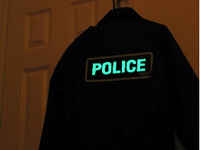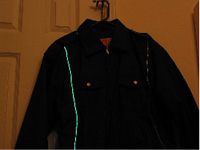|
There is no question that reflective apparel saves lives. There is no debate that an American National Standards Institute (ANSI) compliant high-visibility product has proven time and again its importance in the uniform marketplace. But what if there is a situation where there is no light? What if there is so little light that a reflective strip on a vest doesnt show up in a work-related environment? This is a question that Steve Robinson, Executive Vice President of Liberty Uniform, asked himself during the enormous blackout in the Northeast United States last year. Then he came across a product manufactured by VisionTech. I discovered the VisionTech Active Illumination System at a trade show, says Robinson, but not until I took the product home and turned it on late at night in the pitch dark and looked at it from a great distance did I really appreciate the impact this product has. Robinson was impressed by the active vs. passive safety approach, and now he has an exclusive on bringing this technology to the uniform market. For example, if someone is standing on the highway, but positioned 20 or 30 degrees off the line of sight of a traditional reflective product, such that the headlights of a vehicle are not pointing directly at them, the visibility is lessened. The further that light source gets from that direct line, the more rapidly the reflectivity diminishes. That is what Liberty and VisionTech call passive. Active means that illumination happens no matter what no third-party light source such as a vehicles headlights is required for visibility. Combine this with a regular reflective product and you achieve the strongest safety combination there is, offers Robinson. The product is based on an active, illuminated, battery-powered display versus a retro-reflective, or passive, strip on a high-visibility garment. Any type of situation where there is a low light or no light setting, the garment would still be able to be seen without any other light source. Steve Petre, a representative from VisionTech, explains it this way. In the world of reflective tape and all its derivatives, it can only work if there is a light source shining on the person. In the law enforcement community, many times an officer does not want to be seen, which is why officers are in black or blue, and often dont wear high-visibility attributes as part of the normal uniform. But, in those scenarios where they want to be seen, take for instance the blackout in New York, having an actively illuminated system that is lightweight and non-obtrusive can certainly increase the safety margin or mitigate risk. Beyond law enforcement applications, the potential to help improve injury statistics for highway-related occupations is startling. There are more than 1,000 people killed in road-crew related accidents each year, largely because they cant see or they cant be seen in time. The VisionTech Active Illumination System and related product, an electro-luminescent wire or piping, provides the ability to be seen in no light or low light scenarios, offering greater protection for roadside work. Electro-luminescence is a non-refracting technology invented many years ago. For example, in a snowstorm or a blizzard, if you turn on the high beams of your car, visibility will actually be less than with low beams because of light refracting. Electro-luminescence can be seen through fog or smoke, even indirectly and in the lower right quadrant of your vision, whereas in snow or rain the light is normally refracted all over the place making it hard to see. This may be a slight advantage, but that small edge may be enough in certain cases to save a life by gaining a second or two in reaction time by a driver. In the case of VisionTechs process, a phosphorescent mineral gets printed on a circuit board made of polyester. The entire surface of this circuit board essentially becomes a lamp. That lamp is then encapsulated in rugged PVC, which has certain connections to the power hub. The hub allows the power to flow through the apparel components via a wiring system built into the garment. The design must allow for the rechargeable battery to be incorporated into the garment and be appropriate to the profession for which the clothing is tailored. The location of the battery is more or less important for law enforcement vs. airline employee, for instance. There are in a sense two products, says Petre. The active display is really a panel, which can be anywhere from small to large. But the electro-luminescent wire can be sewn into the seam of any garment. It is a copper wire with a phosphorescent coating, and it is electrified with the battery system. The placement can be of any configuration, across or down, or mimicking an ANSI compliant garment with 360-degree coverage. The battery is a custom-made product, consisting of 4 AA nickel metal hydride cells encapsulated inside a small battery box. This box can be worn in different places on the body, measuring in size about 3 inches high, 2 inches wide and 3/4 inch deep about the size of a deck of cards. The goal is to illuminate a worker for an entire shift and another half, says Petre. 10 to 12 hours of constant illumination. The batteries are rechargeable about 500 times. They can recharge in a cigarette lighter-style vehicle system if needed, or there may be an arrangement where there is a rack of rechargeable batteries in a squad room. We will be manufacturing an ANSI compliant what-if vest, explains Robinson. What if all the lights go out and you are not near a squad car or a flashlight? As a backup system you could reach back and turn on the electro-luminescent piping, which looks natural on your garment until you turn it on, and youve got visibility from a distance of 500 to 1,000 feet. The vest will be a stock item for Liberty Uniform. They will come with vertical tubing or horizontal tubing. There will be a connection built in where the display panel of choice will be attachable. Active field-testing is now underway for final production in the second quarter of 2004. Tunnels or underground work are also good examples of environments where this product will be most appropriate. The goal is not to replace retro-reflectivity but rather be there where retro-reflectivity leaves off. There is the safety benefit, but the product also offers potential promotional value. The system can illuminate a message as easily as it can light up police, traffic or emergency for example. The image could be a corporate logo as well. |
|
| Above story first appeared in MADE TO MEASURE Magazine, Spring & Summer 2004 issue. All rights reserved. Photos appear by special permission. | |
| Halper Publishing Company 633 Skokie Blvd, #490 Northbrook, IL 60062 (847) 780-2900 Fax (224) 406-8850 [email protected] |
|












